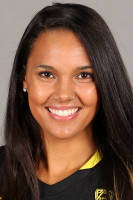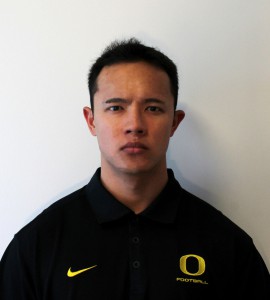Starting Over
Division One Athletes and the Transfer Process.
Story written by Camille Lieurance, Kevyn Fox, and Alexandra Petersen
What makes a good story? Is it something that you have to personally experience or can it simply be an issue that automatically elicits empathy? This was the first question we had to ask ourselves when we received this assignment. We wanted to find a topic that was relevant, not only in the community of Eugene and the University of Oregon, but also relevant on a national scale. Suddenly, it dawned on us. We go to a school that has one of the top ranked athletic programs in the nation. We, as students at the University, have daily interactions with student athletes, yet do not really get the chance to know them as people or how they ended up in the specific programs.
Each individual athlete has their own story of how and why they came to the University of Oregon. In fact, many of them attended schools before they came to Oregon, thus making them transfer student athletes. This is what really interested us. We wanted to know the reason behind student athlete decisions to transfer and what really goes into the process. With a division one athlete (Alexandra) on our creative team, we knew that we had the opportunity and the access, to tell a unique story. The story of what a transfer process looks like, seen from all aspects.
There are numerous concerns for any student, athlete or non-athlete, when transferring, but the stakes especially rise for student athletes. Not only does a student athlete have to go through strict procedures, per the NCAA rules in order to not endanger their scholarship, they also face concerns when it comes to academics, athletic facilities, and coaching environment. There are major concerns that a student athlete faces when making the decision of whether or not to transfer. These concerns are relevant, not only going through the transfer process, but also behind the execution of the actual decision. Student athletes are forced to face issues such as, “what if my credits do not transfer?” or “What if the school is not properly equipped to take care of previous athletic injuries?” or “What if I still do not get the playing time that originally motivated the transfer?” Despite the reasons behind or for the decisions to transfer, student athletes across the country continue to make the hard decision to transfer.
The NCAA has strict requirements for students looking to transfer. In fact, they are often criticized for how difficult the transfer process is for student athletes, as many feel that student athletes should have the freedom to go wherever they please. Per the NCAA’s website, they recommend consulting numerous sources when involved in a transfer process from a division one school to another division one school. The rules for eligibility are different for each respective division that the new school falls under. For example, if a student wants to transfer to a division one school from a division two school, there is a specific list of rules that apply. Each school also has very specific procedures and rules written for their specific programs and what conferences those respective programs fall under.
Numerous restrictions are applied to coaches and student athletes in these transfer situations, which if not obeyed, can nullify one’s eligibility. For starters, student athletes transferring between programs can most certainly expect to sit out for at least a year upon starting at the new school. These restrictions are often made in order to make sure a student is not transferring for the wrong reasons, such as money being offered illegally. However, many argue that this is not the case for the majority of student athletes and that students should be given a free pass to transfer without restrictions. “I know in some sports, they can transfer with no penalty, and I think it should be that way for our sport. I think they shouldn’t have to sit out if they want to go to a new school. Give them a one-time transfer. There are so many different reasons that kids transfer.” Said Kelly Graves, Oregon’s head Women’s Basketball coach, when asked his thoughts, about transferring as a student athlete.
Once the NCAA is satisfied, and a student is cleared to transfer, a new problem arises. Academic credits sometimes fail to transfer between institutions or the same program is not offered. Student athletes, or SA’s, are then often forced to change their academic programs, in order to avoid getting behind. Sometimes, this also happens because an academic institution does not offer a program even close to the one they were previously enrolled in. Jenny Leander, an academic advisor for student athletes at the University of Oregon, has seen first hand how difficult the transfer process can be, with trying to help athletes to transfer credits in. “Katelyn Loper, on the Women’s basketball team is just one example of that. She came as Journalism major at Hofstra, but not enough of her credits transferred, and she had to choose an entirely new major. Unfortunately, it’s something that comes with transferring.” Said Leander, when asked about what she had witnessed while helping students.
However, Katelyn Loper, a redshirt senior on the Women’s basketball team, felt that the transfer decision was worth it, despite her academic barriers and the struggles she faced during the year she was forced to sit out per the NCAA’s rules. “I remember going through this process, and they say the grass isn’t always greener on the other side. But- when I’m all said and done here, to look back and have been able to play at an elite college- and get to be around elite players all the time and hopefully prep me for playing after college is done. That is the most rewarding part.,” said Loper, when asked about if the process was overall beneficial. In short, one can conclude, that although the NCAA’s program seems to be difficult, it works. The transfer process is a complicated one, often motivated by numerous diverse factors, but it is a process that touches everyone. Family members, student athletes, academic advisors, and coaches. All see first hand what the process is really like. These people are where we found our story. Our story describes the transfer process as a student athlete and shows it from all aspects.
When we sat down to reflect, as a group, we made a collective decision to talk about the top three things we are taking away from this learning experience. As a group, we learned quite a bit during this process. Not only about ourselves but also about appropriate and effective ways to work alongside others. First, we learned how to work together on something that was bigger than ourselves. In this case, our project. We all have individual strengths and weaknesses. Kevyn’s specialty is editing, Camille’s is storyboarding, whereas Alexandra is a talented camerawoman. Learning how to combine our strength in order to cancel our weaknesses was our biggest challenge, but we maintained transparency and good communication, which made it possible. Second lesson, we also witnessed first hand the power of following a strict timeline. By setting up a timeline for ourselves, we managed to get all of our work, and were not panicked to find footage. Lastly, we learned that we all are more talented than we know. For example, Camille did not know that she could film from various angles. By trusting in ourselves, to take a risk and go after the story we want, we learned new things about ourselves. At the end of the day, we learned numerous valuable lessons that we will be able to take into the real world.


